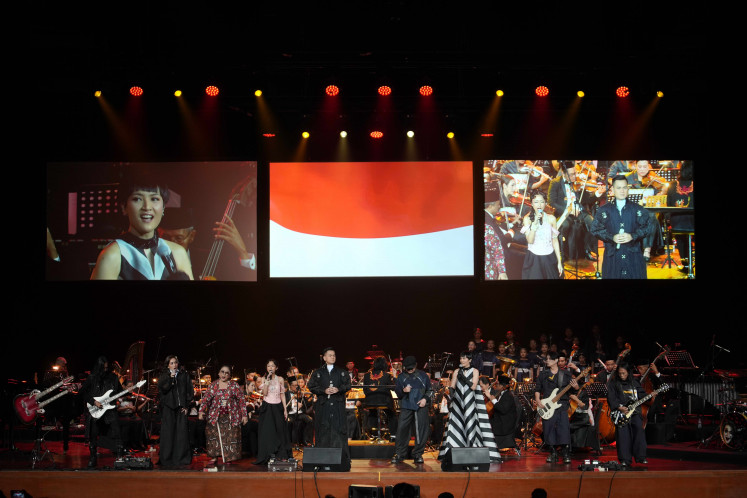Popular Reads
Top Results
Can't find what you're looking for?
View all search resultsPopular Reads
Top Results
Can't find what you're looking for?
View all search resultsConstructing ' and deconstructing ' furniture as fine art
Recycled: Scrap lumber from the production of furniture products and common wood were used to make elegant art wood pieces
Change text size
Gift Premium Articles
to Anyone
Recycled: Scrap lumber from the production of furniture products and common wood were used to make elegant art wood pieces.
Cabinets stood in a slanted position in the corner of the gallery with shelves that remarkably remained parallel to the floor.
Meanwhile, a table and chair in another corner looked as though they were floating. Between them was a large sheet of glass that actually provided support. The furniture pieces were thus transmogrified into a dysfunctional installation.
Yet another slumping cabinet was supported by a log. Titled 'Setimbang Cabinet' (balanced cabinet), this work gave prominence to wood grains and textures that would have otherwise been removed in a conventional piece of furniture.
These were among the works displayed in the recent art wood furniture exhibition, which featured the creations of ISI Surakarta art school graduate Barata Sena in Karanganyar, Central Java.
Although ostensibly 'furniture', the more than a dozen pieces on show went far beyond the conventional. Barata constructed ' or perhaps deconstructed ' amazing cabinets, buffets, tables and chairs.
The piece called Broken Heart Table, for instance, while retaining its full function as a table, derived its name from the crack near one side of the wood surface, making it look like a split table and enhancing the appearance of the design.
The show was Barata's second, following up on his 'Jalan Kayu', or Way of the Wood, show two years ago, when he explored the use of wood in items of clothing such as jackets, vests, scarves, women's wear, and shoes.
'Many furniture entrepreneurs can't accept these pieces. They hesitate to market them abroad, because my works are seen as belonging to the fine arts group, with a very segmented market,' said Barata.
The Setimbang exhibit, according to him, was intended to bridge the gap between fine art and artistic wood furniture. This time he divided his creations into fine art and uFull tilt: Barata Sena trumps notions of form, function and furniture with his canted, yet fully usable, cabinets.tility art. 'The fine art pieces have had their functions changed and to serve decorative purposes and for collectors.'
His Consul table represented the decorative. Benefiting from the winding shape of the piece of wood used, Barata processed its surface to make its grain and motifs appear, adorning it with a glass sheet on top.
Barata feels that there is a difference between art wood furniture and pure furniture. While standard furniture is not allergic to beauty, Barata says that it is principally functionally oriented. On the other hand, art wood furniture prioritizes the esthetic over the functional ' which he says can even be ignored.
For Barata, each pieces should contain something new, although he admitted that no work of art could be totally free of previous designs.
'I'm sure that there are no truly original works of art in the world. We create things inspired by what we frequently see, hear and read, Barata said. 'No works come entirely from a single individual.' Uniquely, he crafted his pieces from wood scraps and second-rate sources such as angsana (Pterocarpus indicus), trembesi (rain trees), fig and banyan trees, rather than those typically chosen for furniture.
'I want to promote the values of wood,' Barata said. 'Through this exhibition, the public should be aware of the many, different valuable species of wood other than just teak. I've no idea of the best quality sought by the market, but good works will come out of good processing.'
Before delving into art wood, Barata studied the nature and properties of over two thousand different types of wood from around the world. In his hands, a simple piece of wood can be transformed into a piece of art.
On close observation, the works on display offered novel constructions and philosophical messages. In presenting his Angel Chair, for example, Barata placed a chair on a high level, floating above the floor.
In its own fashion, the structure implied that only righteous persons going through the correct procedures were worthy of occupying the seat, instead of those attempting to take short cuts to power.
When asked he was alluding to the nation's politics, Barata was ambiguous. 'A work of art always has multiple interpretations. Whatever is displayed here can be read in various ways, depending on the view of observers. I believe they're right.'
The other Setimbang cabinet conveyed the Javanese principle of 'manunggaling kawula lan Gusti', or the union of people and the Creator, through the use of three vertical hollow logs.
Philosophical: 'Manunggaling kawula lan Gusti', or the Javanese concept of the union of God and man, is reflected in this piece.
The first log lay at the bottom, the second was stuck to the right of the first and the third to the left of the second.
The logs thus depicted ways we achieve balance in life through communications with others, nature and God, which requires total resignation for unification, as symbolized by the wood brace on the third leg binding the piece.
Barata's continuous involvement with wood as a medium of expression has led to reflection. From his perspective, a person should be as humble as a tree that produces wood.
Trees struggling hard to survive, facing long droughts, floods and storms, according to Barata's philosophy: After growing large and shady, trees devote their existence to the environment, providing shelter and refreshing the air. Even when they fall, trees give an advantage to their surroundings.
'We should learn from nature,' Barata said. 'A leader should be able to care and give a feeling of security and protection, while showing a more humble outlook than the people he leads.'
' Photos by Ganug Nugroho Adi













